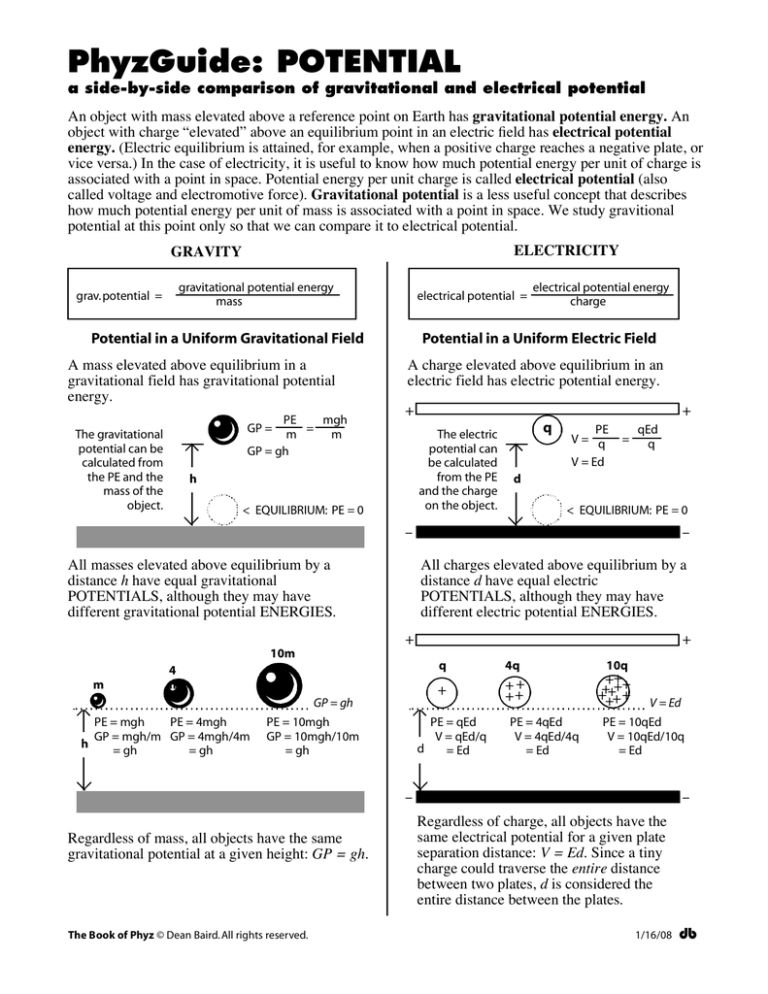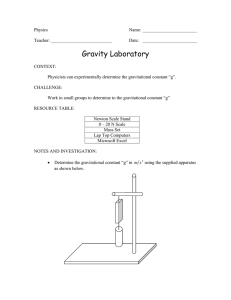
PhyzGuide: POTENTIAL
a side-by-side comparison of gravitational and electrical potential
An object with mass elevated above a reference point on Earth has gravitational potential energy. An
object with charge “elevated” above an equilibrium point in an electric field has electrical potential
energy. (Electric equilibrium is attained, for example, when a positive charge reaches a negative plate, or
vice versa.) In the case of electricity, it is useful to know how much potential energy per unit of charge is
associated with a point in space. Potential energy per unit charge is called electrical potential (also
called voltage and electromotive force). Gravitational potential is a less useful concept that describes
how much potential energy per unit of mass is associated with a point in space. We study gravitional
potential at this point only so that we can compare it to electrical potential.
ELECTRICITY
GRAVITY
grav. potential =
gravitational potential energy
mass
electrical potential =
Potential in a Uniform Gravitational Field
A mass elevated above equilibrium in a
gravitational field has gravitational potential
energy.
PE
mgh
GP = m = m
GP = gh
The gravitational
potential can be
calculated from
the PE and the
mass of the
object.
electrical potential energy
charge
Potential in a Uniform Electric Field
A charge elevated above equilibrium in an
electric field has electric potential energy.
+
+
The electric
potential can
be calculated
from the PE
and the charge
on the object.
h
< EQUILIBRIUM: PE = 0
q
PE
V= q
V = Ed
=
qEd
q
d
< EQUILIBRIUM: PE = 0
–
All masses elevated above equilibrium by a
distance h have equal gravitational
POTENTIALS, although they may have
different gravitational potential ENERGIES.
–
All charges elevated above equilibrium by a
distance d have equal electric
POTENTIALS, although they may have
different electric potential ENERGIES.
+
+
10m
m
4
m
q
4q
+
++
++
GP = gh
PE = mgh
PE = 4mgh
GP = mgh/m GP = 4mgh/4m
h
= gh
= gh
PE = 10mgh
GP = 10mgh/10m
= gh
PE = qEd
V = qEd/q
d
= Ed
PE = 4qEd
V = 4qEd/4q
= Ed
10q
++
++
+++++ +
V = Ed
PE = 10qEd
V = 10qEd/10q
= Ed
–
Regardless of mass, all objects have the same
gravitational potential at a given height: GP = gh.
The Book of Phyz © Dean Baird. All rights reserved.
–
Regardless of charge, all objects have the
same electrical potential for a given plate
separation distance: V = Ed. Since a tiny
charge could traverse the entire distance
between two plates, d is considered the
entire distance between the plates.
1/16/08
db



